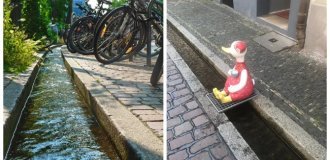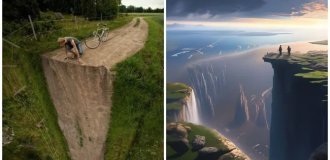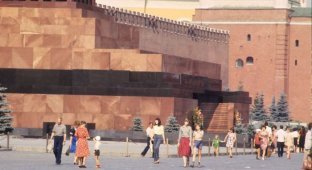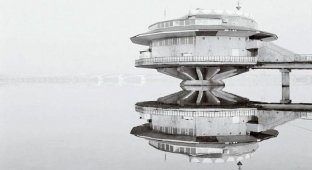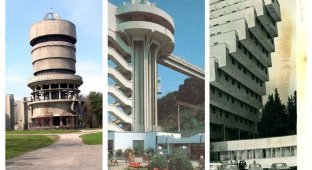Creative and unusual buildings of the 1960s-1980s (26 photos)
A huge selection of the most unusual, creative and strange buildings of the Soviet Union, which were built in the 1960-1980s. There are quite a few interesting projects that evoke nostalgia for those times.
Hotel "Tarelka", Dombay, Russia
Built in 1969 on the slope of Mount Mussa-Achitara, at an altitude of 2250 meters above sea level. The hotel can be transported: it can be disassembled into parts or transported entirely using a helicopter.

Boarding house "Druzhba", Yalta, Ukraine
A joint project of specialists from the USSR and the Czechoslovak Socialist Republic. The building was filmed in the film "Resident Evil: Retribution" (2012), as a former Soviet military base in Kamchatka.

Exhibition complex "Belexpo", Minsk, Belarus
Exhibition pavilion by architect Leonard Moskalevich, 1988.

Engineering Corps of the Ministry of Highways, Tbilisi, Georgia
The building was built in 1975 by architect Georgiy Chakhava, who ironically held the post of Minister of Highways of Georgia at that time, i.e., in fact, the author of the project was also its customer. Between the buildings there is a sloping park with a swimming pool and a cascade waterfall. Now the former ministry belongs to the Bank of Georgia.

USSR Embassy in Cuba, Havana
The complex was built in 1985 according to the design of V. Pyasetsky. Today the Russian Embassy is located here.

Central Research Institute of Robotics and Technical Cybernetics, St. Petersburg, Russia
Built according to the design of S. Savin and B. Artyushin over 14 years (1973-1987), experiments were carried out here with the 16-meter manipulator of the Buran reusable spacecraft.

Summer theater in the park, Dnepropetrovsk, Ukraine
The building was built in 1978 according to the design of the architect O. Petrov in a park pond.

Amalir Sports and Concert Complex, Yerevan, Armenia
Opened in 1983 on Tsitsernakaberd hill. Project by a group of Armenian architects: A. Tarkhanyan, S. Khachikyan, G. Poghosyan and G. Musheghyan. A year and a half after opening, there was a major fire, and the complex was closed for reconstruction until the end of 1987.

Regional Drama Theater in Grodno, Belarus
The building was built in 1977-1984 according to the design of the Moscow Institute “Giprotheatr” (architect G. Mochulsky).

Regional Drama Theater named after F. M. Dostoevsky, Novgorod, Russia
The building was built in 1987 according to the design of V. Somov. Andrei Makarevich, who worked at the Giprotheatr Institute in those years, took part in the work on the construction.

Crematorium, Kyiv, Ukraine
The crematorium at the Baikovo cemetery was built in 1975 according to the design of the architect A.M. Miletsky.

Building of the Kazan State Circus, Kazan, Russia
Opened on December 9, 1967. The building was built according to the design of the architect G. M. Pichuev, engineers O. I. Berim and E. Yu. Brudny.

Cafe "Pearl", Baku, Azerbaijan
Built according to the idea of the city mayor A.D. Lemberansky. Built in the 1960s. Derives from the architecture of the Manantiales restaurant, built in 1958 in a suburb of Mexico City by Spanish architect Felix Candela.

“House-ring” residential area Matveevskoye, Moscow, Russia
Architect - Evgeny Stamo, 1973. Six years later, the twin brother of this house was built. In the courtyards of these buildings there is a green area with a children's playground.

Historical and Ethnographic Museum on Mount Sulayman-Too, Osh, Kyrgyzstan
Built in 1978 on the slope of the sacred mountain Sulaiman-Too according to the design of the architect Kubanychbek Nazarov. A small concrete arch with panoramic glazing divided by vertical ribs closes the entrance to the cave. It was planned to house a restaurant in the building, but then it was given over to an archaeological exhibition. A futuristic portal into the depths of the mountain hides behind it a two-story cave complex, where the lower floor is expanded manually, and the upper one is left in its natural, “natural” form.

Hotel "Salut", Kyiv, Ukraine
Built in 1984 according to the design of the architect A. Miletsky. The building was designed to have 18 floors, but during the construction process it was “cut down” so that it would not compete in height with the bell tower of the Kiev Pechersk Lavra. Experts believe that the author was inspired by the architecture of metabolism, popular in Japan in the 1960s and 70s.

Hotel at the Olympic Sailing Centre, Pirita port, Tallinn, Estonia
Built in 1980, according to the design of Estonian architects, this is a ship in the captain's cabin of which there is a restaurant. The project manager is Henno Sepmann. The current name is Pirita Top Spa Hotell.

Railway station, Dubulti station, Jurmala, Latvia
Built in 1977 for the centenary of the station, according to the design of the architect Igor Georgievich Yavein. The Baltic wave frozen in concrete is both a reference to the Soviet architectural avant-garde of the 1920s and a kind of predecessor of modern “space” architecture.

Pavilion on the territory of VDNH of the Uzbek SSR, Tashkent, Uzbekistan
Built in the 1970s. Unfortunately, this building has not survived to this day. The source of inspiration for the architects of the pavilion was obviously the Cathedral in Brasilia, the architect Oscar Niemeyer, a communist and great friend of all the Soviet people.

Cinema "Russia", Yerevan, Armenia
The building was erected in 1975 in the central part of the Armenian capital under the leadership of a creative group of architects (G. Poghosyan, A. Tarkhanyan, S. Khachikyan).

Khmelnitsky Regional Literary and Memorial Museum of Nikolai Ostrovsky, Shepetivka, Ukraine
The ring, according to the authors of the project M. Gusev and V. Suslov, symbolized a wreath dedicated to the memory of the writer, and the pylons supporting it symbolized the hands of admirers of Ostrovsky’s talent. A scarlet smalt mosaic is a red banner around a memorial wreath. 1979

Building of the Russian Academy of Sciences, Moscow
Construction began in 1974 and was completed 20 years later; at the time construction began, the project had no analogues in Moscow. The main decorative element is artistic compositions made of metal and glass. People called them “golden brains”; there are many legends about their real purpose, including ideas of “conspiracy theories”.

Ilya Chavchavadze Museum, Kvareli, Georgia
The museum of the Georgian poet and publicist Ilya Chavchavadze was designed by one of the most avant-garde Soviet architects, Viktor Jorvenadze, and commissioned in 1979.

Hotel Olympia, Tallinn, Estonia
In 1980, together with the Olympia Hotel, a variety show was opened on its ground floor. The building was designed by architects Toivo Kallas and Rein Kersten.

House of Soviets, Kaliningrad, Russia
Construction of the building began in 1970 and was completed relatively recently. It is located on the site of the former Königsberg castle and for a long time it was the most famous unfinished construction project in the west of Russia. The project of Lev Misozhnikov and Galina Kucher was nicknamed “buried robot” by local residents.

Palace of Ceremonies, Tbilisi, Georgia
Erected in 1985 according to the design of Victor Jorvenadze. During the years of independence, the building was bought by a reputable local businessman, Badri Patarkatsishvili. Here, on the territory of the former wedding palace of the capital of Soviet Georgia, he was buried in 2008.


